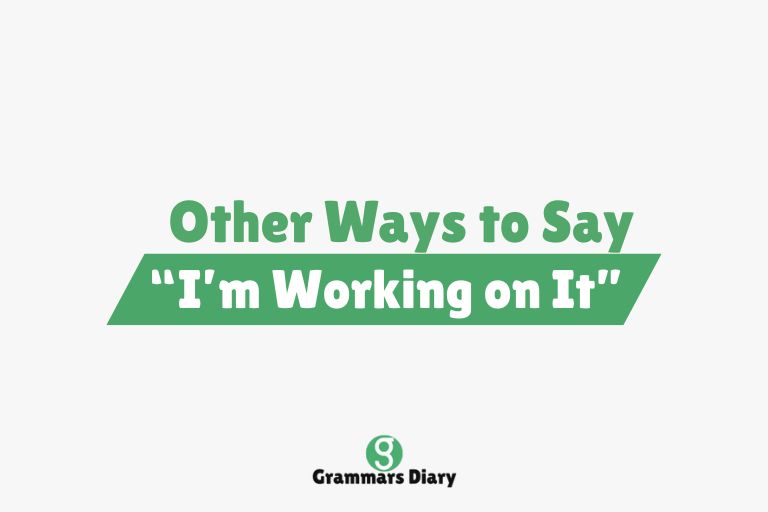“I’m working on it” is a commonly used phrase that people rely on when they want to indicate progress without giving away too many details. Whether it’s at work, in casual conversations, or during school projects, this phrase often serves as a quick, polite way of saying that something is in motion—even if you’re still in the early stages or just thinking about how to begin. But repeating it too often can sometimes sound vague, or worse, like a delay tactic. That’s why it’s useful to have alternative ways to express the same idea—ways that can offer more nuance, more professionalism, or even a bit more honesty depending on the situation.
This article dives into 22 thoughtful, specific, and context-appropriate phrases that you can use instead of just saying “I’m working on it.” Whether you’re talking to a client, your boss, a team member, or a friend, these alternatives will help you communicate with more clarity, precision, and even a little charm.
Other Ways to Say “I’m Working on It”
1. I’m making progress on it
Example: “I’m making progress on it and should have an update by tomorrow.”
Meaning: This version adds a sense of momentum and assures the listener that something is being actively done.
Usage: Ideal when you’ve already started the task and want to confirm that things are moving forward without giving a final timeline.
2. I’m in the middle of it
Example: “I’m in the middle of it right now and hope to wrap up soon.”
Meaning: This implies that you’re currently engaged with the task and not just thinking about it or postponing it.
Usage: Best used during real-time updates to reflect your active involvement.
3. I’m handling it
Example: “No worries—I’m handling it as we speak.”
Meaning: This phrase suggests control and capability, implying you’ve taken ownership of the task.
Usage: Useful in professional or managerial situations where confidence is key.
4. It’s in progress
Example: “The report is in progress and I’ll notify you once I hit the next milestone.”
Meaning: Slightly more formal, this alternative speaks to ongoing effort in a neutral, professional tone.
Usage: Appropriate for status reports and project check-ins.
5. I’m on top of it
Example: “Don’t worry, I’m on top of it and won’t let anything slip through the cracks.”
Meaning: This conveys proactive management and readiness, reassuring the listener of your diligence.
Usage: Excellent when you want to communicate competence and reliability.
6. I’ve started on it
Example: “Yes, I’ve started on it and will update you as I make more progress.”
Meaning: This version highlights that the task is no longer pending—it’s already underway.
Usage: Perfect when responding to someone checking in for the first time.
7. I’m addressing it
Example: “Thanks for pointing that out—I’m addressing it now.”
Meaning: This alternative works well when fixing issues or responding to feedback.
Usage: Common in customer service or troubleshooting scenarios.
8. I’m actively working on it
Example: “I’m actively working on it and allocating time every day to make sure it’s done right.”
Meaning: Adds emphasis on your commitment and involvement, signaling that the task has your attention.
Usage: Best when you need to stress that it’s a priority for you.
9. I’m ironing out the details
Example: “I’m ironing out the details to make sure everything aligns before moving forward.”
Meaning: Conveys that you’re refining something that’s already been initiated.
Usage: Ideal in collaborative or planning-focused conversations.
10. I’m putting things together
Example: “I’m putting things together now and should have a draft soon.”
Meaning: This offers a creative, constructive spin on the task, suggesting that you’re assembling components toward completion.
Usage: Great when dealing with presentations, reports, or design projects.
11. It’s underway
Example: “It’s underway, and I’ll keep you posted as it progresses.”
Meaning: A more formal option that indicates official movement or execution.
Usage: Well-suited to business communications, especially emails or formal updates.
12. I’m taking care of it
Example: “I’m taking care of it and will follow up once everything’s finalized.”
Meaning: This phrase adds a personal sense of responsibility, suggesting not just task execution but also thoughtful attention to its completion.
Usage: Commonly used in informal as well as semi-professional contexts, especially when you want to show accountability.
13. It’s on my radar
Example: “It’s definitely on my radar and I plan to make time for it this afternoon.”
Meaning: This version communicates awareness and intent, even if active work hasn’t yet begun.
Usage: Best used when you’ve acknowledged a task but haven’t yet prioritized it at the top of your list.
14. I’m getting to it
Example: “I’m getting to it soon—just wrapping up one more task first.”
Meaning: This is a casual way to indicate that the task is next in line, showing realistic time management.
Usage: Ideal for informal team updates or honest responses among peers.
15. I’m making headway
Example: “I’m making headway and will have more concrete results to show you by the end of the week.”
Meaning: Implies steady, measurable progress and the sense that the work is moving in the right direction.
Usage: Best for ongoing projects or long-term efforts where milestones matter.
16. It’s in motion
Example: “Everything’s in motion now—we’ve already kicked off the first steps.”
Meaning: Suggests momentum and active planning, especially when multiple components or people are involved.
Usage: Suitable in collaborative settings or when describing team-based progress.
17. I’m putting in the work
Example: “I’m putting in the work to make sure it gets done thoroughly.”
Meaning: A confident, direct phrase that communicates effort and persistence.
Usage: Ideal for personal branding or when you want to show dedication to high standards.
18. I’m on it
Example: “I’m on it—this won’t fall through the cracks.”
Meaning: One of the shortest and most assertive ways to say you’re taking responsibility.
Usage: Great for fast-moving conversations, especially when quick action is needed.
19. I’m in the process of completing it
Example: “I’m in the process of completing it and just need a bit more time.”
Meaning: A more formal way to say that you’re nearing the end of the task.
Usage: Excellent for workplace communications, especially when you want to project professionalism.
20. I’ve got it covered
Example: “You don’t need to worry—I’ve got it covered.”
Meaning: This version combines confidence with assurance, signaling that everything is under control.
Usage: Perfect for calming concerns or taking responsibility in high-stakes tasks.
21. It’s being taken care of
Example: “Rest assured, it’s being taken care of as we speak.”
Meaning: This passive voice alternative offers formality while still promising completion.
Usage: Useful in email updates or formal replies, especially in client-facing contexts.
22. I’m wrapping it up
Example: “I’m wrapping it up now and should be ready to deliver shortly.”
Meaning: Indicates final-stage work and prepares the listener for imminent results.
Usage: Best for status updates when you’re approaching the finish line.
When to Use Different “I’m Working on It” Alternatives
In Professional Settings
In formal business or corporate environments, the way you speak about progress can significantly impact how others view your professionalism and efficiency. Phrases like “It’s underway,” “I’m in the process of completing it,” or “I’m addressing it” help convey competence and structured workflow without being too vague or dismissive.
In Casual Conversations
When chatting with friends, family, or coworkers in an informal tone, it helps to sound authentic and approachable. Options like “I’m getting to it,” “I’ve got it covered,” or “I’m putting things together” strike a more relaxed balance, showing that you’re engaged without sounding stiff or overly formal.
In Project and Task Management
In environments focused on teamwork and deadlines, it’s often helpful to reflect clarity about where you are in the task. Saying “I’m making progress,” “I’m wrapping it up,” or “I’m ironing out the details” gives team members or supervisors better insight into timing, potential blockers, or collaboration points.
Conclusion
“I’m working on it” is one of those phrases that serves us well in many situations—but using it too often or in the wrong context can make communication feel repetitive or even uncertain. As we’ve explored in this guide, there are plenty of clear, smart, and context-appropriate alternatives that can help you express your progress more effectively and with greater precision. Whether you’re giving updates at work, explaining delays to a friend, or managing complex projects, these phrases allow you to adapt your message to the tone, setting, and expectations of your audience—showing not just that you’re working, but how you’re working.
For those who want to deepen their vocabulary and explore even more expression tools, online resources like Thesaurus.com can offer a rich collection of ideas for nuanced phrasing and smarter communication.
FAQs
What does “I’m working on it” mean?
It’s a phrase used to indicate that a task has already been started or is in the process of being completed, often serving as a placeholder during conversations about status or timelines.
Is “I’m working on it” appropriate in professional settings?
Yes, it’s commonly used in work environments, but switching it up with more descriptive alternatives like “I’m handling it” or “It’s in progress” can sound more polished and specific.
How do I know which alternative to use?
The best phrase depends on your audience, the level of formality, and your actual progress. For formal updates, use terms like “in progress” or “I’m addressing it.” For casual check-ins, stick with “I’m getting to it” or “I’ve got it covered.”











